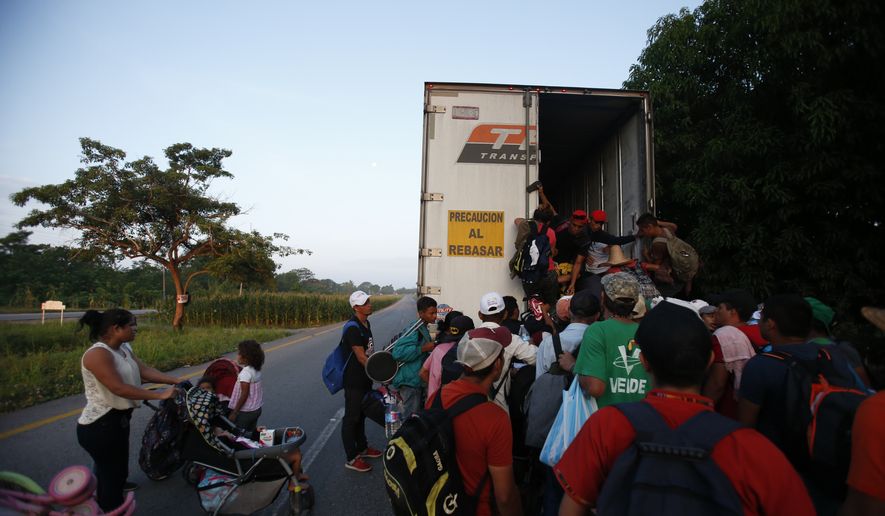Darlyn Josue Mass-Montenegro paid $13,000 to be smuggled from Honduras to Los Angeles, doling out big payments for every leg of the journey.
His first $3,000 went to smugglers in Honduras, then he paid $1,500 more in southern Mexico, $2,000 in northern Mexico and $1,500 to the stash house operator who kept him holed up at a car wash near McAllen, Texas.
He was paying $2,000 to be packed in the back of a truck hauling watermelons and driven through the Falfurrias Border Patrol checkpoint en route to Houston. He owed a final $3,000 once he was in Los Angeles.
He never made it, getting snared, along with 22 other illegal immigrants amid the watermelons. But the thousands he had already paid was free and clear for the smugglers who got him that far.
The story is repeated hundreds of thousands of times over, both for those who get caught and for those whom the Border Patrol never detects. As their numbers grow, they line the pockets of some of the world’s most dangerous organizations, Homeland Security Department authorities say.
The Rand Corp. is releasing a report Monday putting a dollar amount on at least some of that traffic. It estimates that Central American migrants paid as much as $2.3 billion to be smuggled into the U.S. in 2017.
At the same time, Rand said, the cartels’ take could be as low as $200 million.
Rand made its calculations based on high and low estimates for migrants’ payments and then calculations of how many people actually made the journey. They limited their study to those from the Northern Triangle: the countries of Guatemala, Honduras and El Salvador.
Rand identified four types of operators in the human smuggling trade, ranging from independent operators who offer their own services such as driving or guiding, all the way to formal networks run by a single kingpin who can monopolize a route of traffic.
The formal networks, the organized smuggling cartels, are the most notorious. Homeland Security officials say those cartels either operate in coordination with, or are the same as, drug smuggling organizations.
Yet Rand said it’s likely the less-formal networks and independent operators are the ones making the most money from human smuggling.
“We learned that human smuggling involves many different types of actors and that we could not credibly distinguish most criminal organizations’ activities and revenues from those of other actors, including ad hoc groups and independent operators, that engage in human smuggling,” said Victoria Greenfield, the report’s lead author. “At best, we could provide a broad range for the revenues to all types of human smugglers.”
Rand said one pot of money from smuggling routes almost certainly ended up in the drug cartels’ hands: The “piso,” or tax, was paid to use the cartels’ routes across the U.S.-Mexico border. The tax generally ranged from $300 to $700, Rand said.
Northern Triangle country migrants paid $30 million to $180 million in pisos in 2017, researchers estimate.
Rand’s research was sponsored by Homeland Security.
The numbers Rand used are 2 years old and cover a time when migration plummeted after President Trump took office.
Those numbers have since surged to levels not seen in more than a decade. The cost of transiting has also soared.
The Washington Times has found that the tax paid to cartels — what the migrants also refer to as the “mafia fee” — has grown, with a $1,000 payment common.
Costs, however, vary dramatically, according to data The Times compiled over the past year from court documents in thousands of border smuggling cases.
For example, a truck caught at a Border Patrol checkpoint in Texas on April 11 had one Honduran migrant paying $11,000, an Ecuadorian paying $9,000 and a Mexican who paid only $1,200 — a $200 crossing fee and $1,000 for the truck ride to Houston.
In California, Mexicans snared in four vehicles at the same border crossing on the same day paid $3,000, $5,000, $7,000 and $15,000 for their trips.
Overall, Central Americans say they pay more than Mexicans, and rates rise further for those from South America. Migrants from Brazil can expect to pay in the neighborhood of $20,000 for their trip.
Those from China might pony up $70,000 or more.
The Chinese tend to be caught crossing at ports of entry, contorted into vehicles’ dashboards or in aftermarket compartments under cars designed specifically to try to fool Customs and Border Protection officers.
• Stephen Dinan can be reached at sdinan@washingtontimes.com.




Please read our comment policy before commenting.